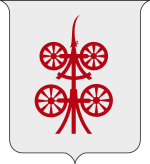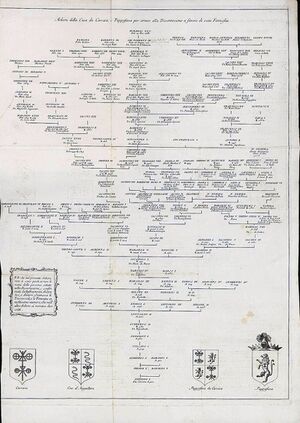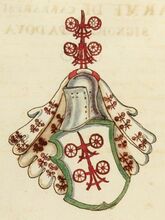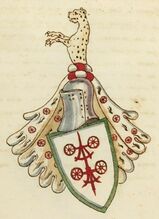كراريزي
| Carraresi | |
|---|---|
 | |
| تأسست | 10th century |
| المؤسس | Gumberto |
| آخر حاكم | Francesco Novello da Carrara |
| الألقاب | |
| الانحلال | 15th century |
| الإطاحة | 1435 |
| الفروع | Papafava |
بيت كرارا House of Carrara أو كراريزي Carraresi (دا كرارا) كانت عائلة مرموقة في شمال إيطاليا في القرون 12-15. احتفظت العائلة بلقب لوردات پادوا من 1318 حتى 1405.
وتحت حكمهم، فتحت پادوا مدن ڤـِرونا و Vicenza, Treviso, Feltre, Belluno, Bassano, Aquileia و أودينى، وبذلك سيطرت على معظم ڤـِنـِتو وجزء من فريولي. إلا أنه في 1405 انهزمت پادوا وعائلة كرارا أمام جمهورية البندقية، مما منع بشكل فعال خلق دولة إقليمية أكبر تكون پادوا عاصمتها.[1]
التاريخ
As signori of Padua, their overwhelming power and patronage placed them in an isolated position far outshining any other single family. Their extensive land holdings in the Paduan contado were supplemented by extensive property within the comune itself, and their political prominence made them comparable to the Scaligeri of contemporary Verona, or the Visconti of Milan.[2] Margaret Plant has examined how "in its period of domination in Padua from 1337 to 1405 the house of Carrara sustained a singular chapter in the history of patronage".[3] Francesco il Vecchio, son of Giacomo, a close friend of Petrarch in his early years,[4] was a noted patron of Petrarch himself and commissioned frescoes (destroyed) illustrating Petrarch's De viris illustribus in the palazzo, c. 1367–1379, employing Guariento and others;[5] Petrarch's retirement years were spent at Arquà, a Carrara fief, and he bequeathed to Francesco his picture of the Virgin by Giotto.
Coming from Carrara Santo Stefano, near Padua, the family had their origin in a certain Gamberto/Gumberto, of Lombard origin, to judge from his name and that of his son Luitolfo, founder of the abbey of Carrara in 1027; Gumberto was signore of castrum Carrariae, the Castello of Carrara San Giorgio.[6] Faithful to the emperors generation after generation, after becoming lords of Pernumia, in 1338 they ousted the Veronese della Scala from Padua and became the lords of that city. In 1388 a coalition of Milanese and Venetians forced Francesco il Vecchio to abdicate in favor of his son. The Venetians annexed Padua as Venetian territory in 1405. The elder Cararrese line was extinguished with the murders of Francesco Novello da Carrara and all his sons but Marsilio and bishop Stefano in a Venetian prison in 1406; Marsilio died soon after, and Stefano fled to Rome, where he lived until 1448; all Paduan bishops to the end of the Venetian Republic (1797), with two exceptions, were Venetian nobles.[7] The Baptistery at Padua, which was under Carrarese patronage and served as their mortuary chapels, reverted to the bishop and the cathedral chapter; its Carrarese tombs were removed when the floor level was raised.[8]
Part of their palace in Padua is still standing. Notable parts are the Loggia and the Sala dei Giganti. They erected the important Abbazia di Santo Stefano abbey in the locality Carrara Santo Stefano, between the modern Due Carrare and Padua. The abbey's church, dedicated to Saint Stephen, is still standing today and contains, among others, the tomb of Marsilio da Carrara.
In the 15th century the Carraresi were represented in the cadet male line of the two descended from 13th-century brothers Marsilio (the elder) and Jacopino (the younger). The imprese of the family coat of arms is a four-wheeled cart (carro), and the family colors are red and white, in a checkerboard arrangement.
قصة الحضارة
كانت بادوا حاضرة إيطالية كبرى في عهد ديكتاتورية عائلة كراريزي Carraresi تنافس البندقية وتهددها بالخطر، وقد انضمت فعلاً إلى جنوى في عام 1378 وحاولتا معاً أن تخضعا الجمهورية القائمة في هذه الجزيرة، وفي عام 1380 حين أنهكت الحروب مع جنوى قوى البندقية أسلمت هذه إلى دوق النمسا مدينة تريفيزو Treirso ذات المركز الحربي الهام والواقعة في شمالها، وفي عام 1383 ابتاع فرانتشيسكو الأول صاحب كرارا تريفيزو من النمسا، ثم حاول بعد قليل من ذلك الوقت أن يستولي على فيتشندسا وأودينى Udine وفريولي، ولو انه نجح في هذا لسيطر على الطرق المؤدية من البندقية إلى مناجم الحديد التابعة لها عند أجوردو Agordo وعلى الطرق التي تسلكها تجارة البندقية وتجارتها. ولكن البندقية نجت من هذا الخطر بفضل مهارة رجالها الدبلوماسيين، فقد أقنعوا جيان جلياتسو فيسكونتي بالانضمام إلى البندقية في حربها ضد بدوا. وما من شك في أن جيان لم يكن يثق بالبندقية، غير انه مع هذا اغتنم هذه الفرصة التي سنحت له لتوسيع رقعة بلاده نحو الشرق بتغاضي البندقية، وهزم فرانتشيسكو صاحب كرارا (فرانتشيسكو كرارا) ونزل عن عرشه (1389)، وجدد ابنه، سميه وخلفه (1399)، معاهدة عام 1338 التي اعترف فيها بأن بدوا تابعة للبندقية. ولما أن واصل فرانتشيسكو الثاني صاحب كرارا الكفاح، وهجم على فيرونا وفيتشندسا أعلنت بدوا لمجلس الشيوخ يحكمها حكماً مباشراً (1405). وتخلت المدينة المنهوكة القوى عن ذلك الترف المستغل الوطني، وازدهرت في ظلال الحكم الأجنبي القدير الحازم، وأصبحت المركز التربوي لأملاك البندقية، يهرع إلى جامعتها الذائعة الصيت الطلاب من جميع أنحاء العالم المسيحي اللاتيني - بيكو دلا ميرندولا Paico della Mirandola، وأريستو، وبمبو، وجوتشيارديني Guieciardini، وتسو، وجالليو، وجستافس فازا Gustaus Vasa الذي صار ملك بولندة ... وأنشأ دمتريوس كلكنديلس Demetrius Chalcondyles فيها كرسياً للغة اليونانية قبل أن يرحل إلى فلورنس بستة عشر عاماً. وكان في وسع شكسبير بعد مائة عام من ذلك الوقت أن يتحدث عن بدوا الجميلة مهد الفنون.
وكان في بادوا من أهلها رجل يرى نفسه معهداً علمياً قائماً بذاته، ذلك هو فرانتشيسكو سكوارتشيونه Francesco Squarcione الذي تعلم أولاً حرفة الخياطة، ثم أولع بالفن القديم، وطاف في كثير من أنحاء إيطاليا واليونان، ونسخ الرسوم والنقوش التي على التماثيل والعمائر اليونانية والرومانية، أو رسم لها صوراً تخطيطية، وجمع المدليات وقطع النقود، والتماثيل القديمة، ثم عاد إلى بدوا يحمل مجموعة من أحسن المجموعات القديمة في أيامه، وافتتح فيها مدرسة لتعليم الفن، وضع فيها مجموعته، ورسم لتلاميذه منهجين أساسيين: دراسة الفن القديم وعلم المنظور الحديث: ولم يبق في بدوا من الفنانين البالغ عددهم مائة وسبعة وثلاثين والذين نشأوا على يديه إلا عدد جد قليل لأن كثرتهم قد جاءت إليها من خارجها. ولكنها استعاضت عن هذا بأن جاء إليها جيوتو من فلورنس ليصور فيها حلبة المظلمات، وأولتيتشيرو Oltichiero من فيرونا (حوالي 1376) لينقش فيها معبداً في كنيسة القديس أنطوني St. Antthony ودوناتيلو الذي خلف ذكريات من عبقريته في الكنيسة الكبرى وميدانها. وأقام بارتولميو بلانو أحد تلاميذ دوناتيلو تمثالين جميلين لامرأتين في معبد جتاميلاتا Gattamelata في هذه الكنيسة نفسها، وأضاف بيترو لمباردو البندقي تمثالا جميلا لابن أفاق مغامر وقبراً فخماً لأنطونيو روزيللي Antonio Roselli. ونحت أندريا بريوسكو Andrea Briosco - رتشيو Rieceo - وأنطونيو، وتوليو لومباردو Tullio Lombardo لمعبد جتا ميلاتا أيضاً نقوشاً في الرخام، كما أقام رتشيو في إيطاليا، ثم اشترك مع ألسندرو ليوناردو البندقي وأندريا موروني البرجامي (of Bergamo) في تخطيط كنيسة القديسة جوستينا Giustina (1502 وما بعدها) التي لم تتم، والتي كانت طرازاً خالصاً من فن النهضة المعماري.
وكانت بدوا وفيرونا المدينتين اللتين جاء منهما ياقوبو بليني وأنطونيو بيزانيلو إلى البندقية بمبادئ مدرسة البندقية في التصوير التي منها ذاعت شهرة البندقية في العالم أجمع.
أبرز أفرادها
- Gumberto (died before 970)
- Gumberto (died before 1027)
- Litolfo da Carrara (died before 1068), who founded the Abbazia of Santo Stefano in Due Carrare (1027).
- Artiuccio
- Gumberto (known in 1077)
- Marsilio (known in 1109)
- Marsilio (died before 1210)
- Jacopino (died before 1262)
- Jacopo I, called "The Great", lord of Padua (died 1324)
- Marsilio, lord of Padua (died 1338)
- Ubertinello, lord of Padua (died 1345)
- Marsilietto Papafava, lord of Padua (died 1345)
- Jacopo II, lord of Padua (d. 1350)
- Francesco "il Vecchio", lord of Padua (abdicated in favor of his son, 1388; died a prisoner of Giangaleazzo Visconti at Monza, 1393)[9]
- Francesco Novello (1359–1406)
- Francesco III (died 1405)
- Giacomo (died 1405)
- Marsilio (died 1435)
الدروع
درع جاكومو الأول
درع مارسيليو
درع كراريزي يعلوه درع فرانشسكو الأقدم، وهو العربي ذو القرون والأجنحة الذهبية، المتدثر بالأحمر والذهبي
الهامش
- ^ Cittadella, Giovanni. Storia Della Dominazione Carrarese In Padova V1 (in الإيطالية). Kessinger Publishing.
- ^ Noted by Diana Norman, Siena, Florence, and Padua: Art, Society and Religion, 1280–1400 (Yale University Press), 1995, vol. I, ch. 8 "Splendid models and examples from the past: Carrara patronage of art", p. 155.
- ^ Margaret Plant, "Patronage in the circle of the Carrara family", in Francis William Kent et al. Patronage, Art, and Society in Renaissance Italy 1987, p. 377.
- ^ A. Zardo, Il Petrarca e i Carraresi (Milan, 1887) noted by Mommsen 1952:96 note 13.
- ^ Theodor E. Mommsen, "Petrarch and the Decoration of the Sala Virorum Illustrium in Padua", The Art Bulletin 34.2 (June 1952), pp. 95–116, dates p. 99.
- ^ Due Carrare official website: "La storia" Archived 2008-12-14 at the Wayback Machine
- ^ Saalman 1987:379, 384.
- ^ Saalman 1987:384ff.
- ^ His tomb in the Paduan baptistery is commonly exampled as the model for the Medici tombs in the Old Sacristy of San Lorenzo, Florence (Howard Saalman, "Carrara Burials in the Baptistery of Padua", The Art Bulletin 69.3 [September 1987], pp. 376-394).
المصادر
- Kohl, Benjamin G. (1998). Padua under the Carrara, 1318–1405. Baltimore: Johns Hopkins University Press. ISBN 0801857031.







